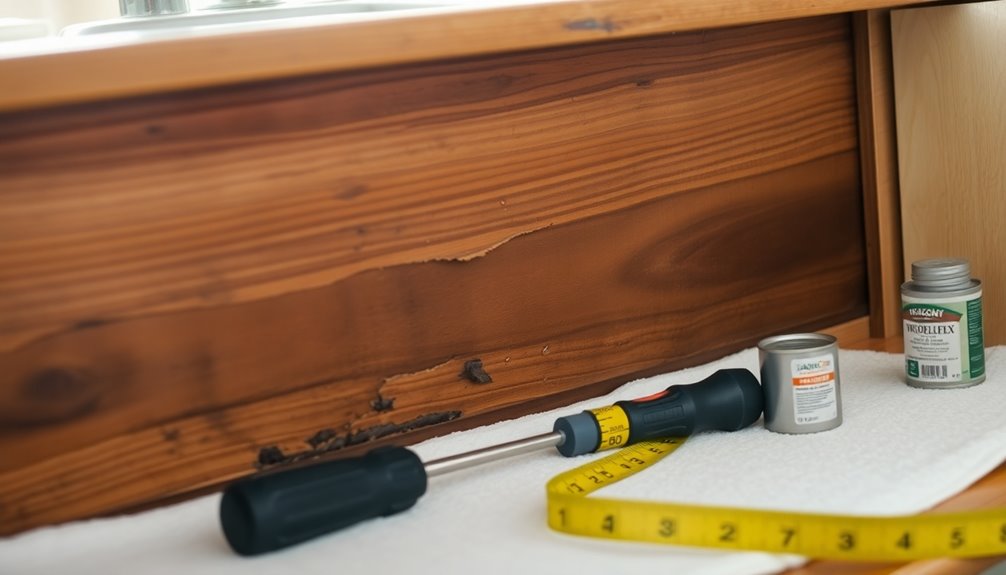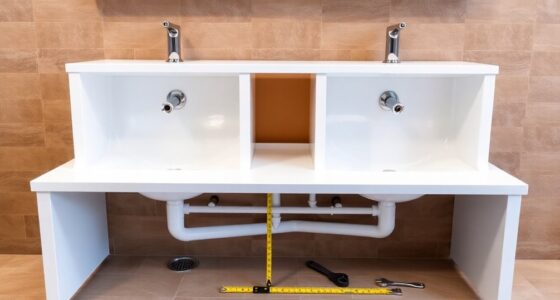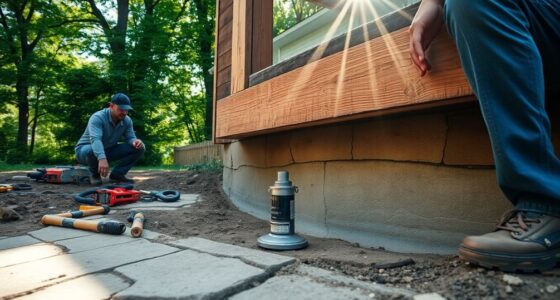To repair water-damaged cabinets under your sink, start by evaluating the damage for discoloration, mold, or rotting wood. Remove any severely damaged sections and treat the healthy wood with a hardener. Fill in voids with wood filler or epoxy, then replace lost material with moisture-resistant plywood. Seal seams and check for leaks or plumbing issues to prevent future damage. With these steps, you can restore your cabinet effectively, and there's more to learn about prevention techniques.
Key Takeaways
- Inspect the cabinet for discoloration, musty smells, and mold to assess the extent of water damage.
- Remove any rotted wood using a chisel or utility knife, then treat exposed areas with wood hardener.
- Fill any voids with wood filler or epoxy, and replace severely damaged sections with moisture-resistant plywood.
- Seal seams and edges with caulk to prevent future moisture infiltration and ensure proper ventilation.
- Regularly inspect plumbing for leaks and maintain cabinets with waterproof materials to prevent future damage.
Identifying Water Damage Under Sink
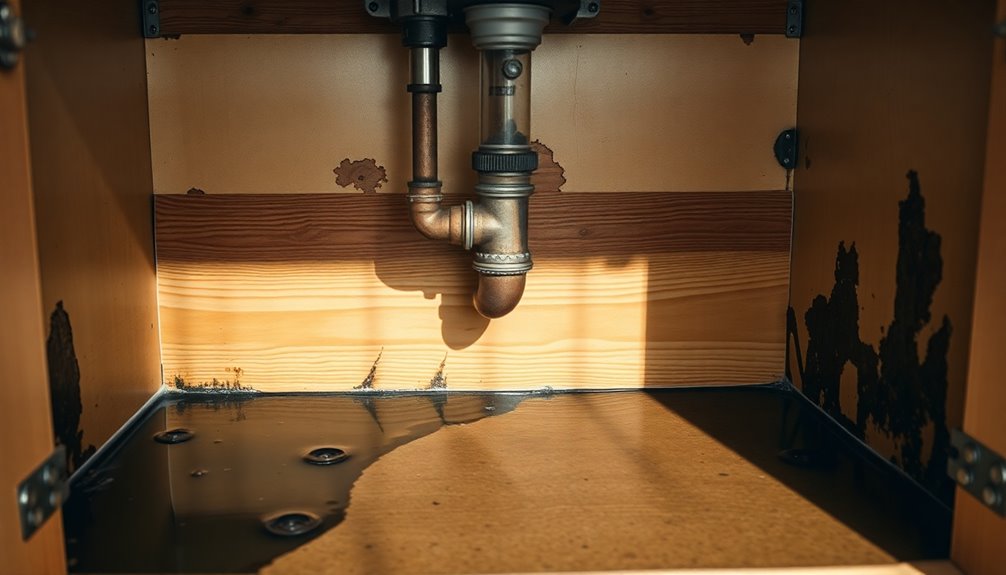
You mightn't realize it, but identifying water damage under your sink is essential for maintaining your cabinet's integrity.
Start by checking for discoloration or staining on the cabinet floor; these are clear signs of moisture infiltration. If you notice a musty or damp smell, it likely indicates moisture buildup and potential mold growth.
Be on the lookout for warping or buckling of the cabinet floor, as these are strong indicators of prolonged water exposure.
Finally, the presence of mold or mildew suggests serious water damage that requires immediate attention. Ignoring these signs not only risks rotting wood but can also compromise your cabinet's structural integrity, leading to costly repairs.
Stay vigilant to protect your investment!
Potential Causes of Water Damage Under the Sink
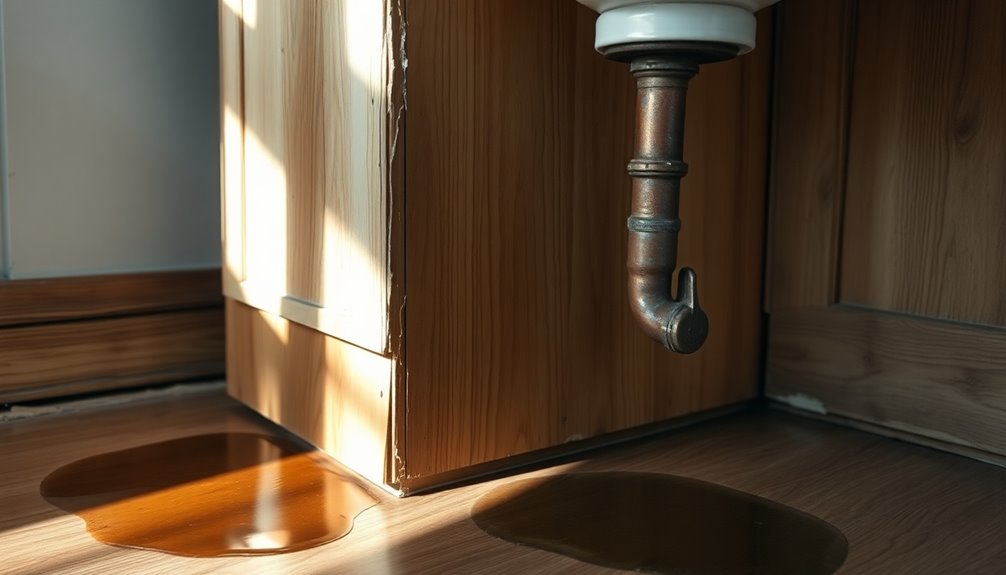
Water damage under the sink can occur for several reasons, often stemming from issues with plumbing components.
Leaky pipes, typically from wear and tear or loose connections, are the most common culprits. You might also notice condensation forming on cold water pipes, especially in humid environments, which can lead to moisture buildup over time.
Improper sink drainage, caused by clogs or misalignment, may allow water to overflow and seep into the cabinet. Additionally, sealant failure around the sink or faucet can create leaks, letting water infiltrate the cabinet area.
To reduce the risk of water damage, make sure you regularly inspect your plumbing components and address any issues promptly.
Step-by-Step Guide on Fixing Water Damage
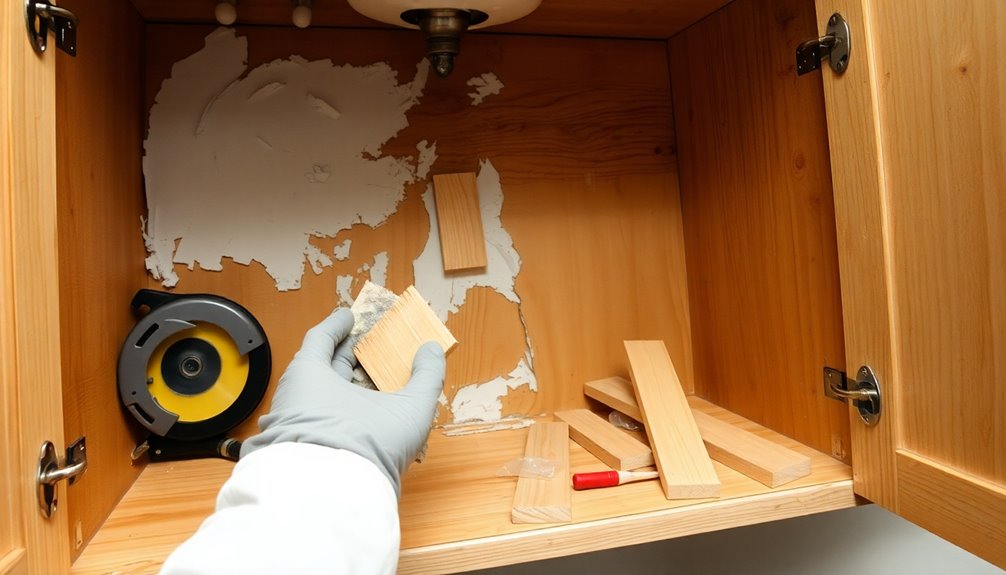
To fix water damage in your cabinet, you'll need to start by evaluating the extent of the damage.
Once you know what you're dealing with, you can choose the right repair techniques to restore it.
Finally, implementing preventive measures will help keep your cabinet safe from future issues.
Assessing Damage Extent
How can you effectively assess the extent of damage in your cabinet after water exposure?
Start by closely inspecting for signs of water damage. Look for:
- Discoloration on the wood
- Musty odors indicating mold
- Warping or swelling of surfaces
- Soft or crumbling areas
Once you've identified the affected areas, use a chisel or utility knife to carefully remove any rotted wood.
Be certain to keep the structural integrity intact. After that, treat the exposed wood with a wood hardener to reinforce it and prevent future rot. Regular maintenance and monitoring can help prevent air quality issues that may arise from mold growth.
If necessary, fill any voids with wood filler or epoxy. For extensive damage, you might need to replace the entire cabinet base or floor with plywood to guarantee durability and moisture resistance.
Repair Techniques Overview
Repairing water-damaged cabinets can be tackled in five straightforward steps.
First, assess the water damage by checking for rotted wood or mold, removing any loose material.
Next, clean the affected area using a 50/50 vinegar and water mixture to eliminate mold spores, then let it dry completely.
After that, cut out any severely damaged sections of the cabinet base and replace them with new plywood or particle board, ensuring a snug fit.
Secure the new material with nails or construction adhesive, and reinforce with 2x4s if needed.
Finally, seal all seams and edges with caulk to prevent future moisture infiltration, and consider applying a waterproof sealant to enhance durability against water damage.
Preventive Measures Implementation
While water damage can be a hassle, implementing preventive measures can considerably reduce the risk of future issues.
Here's a step-by-step guide to help you safeguard your cabinets:
- Inspect plumbing regularly: Check for leaks and tighten loose connections to prevent issues before they arise.
- Apply waterproof sealant: Use it on seams and edges of cabinetry to block moisture infiltration, especially in spill-prone areas.
- Choose waterproof materials: Opt for marine-grade plywood for cabinet bases to enhance moisture resistance.
- Ensure proper ventilation: Install a small fan or leave doors open periodically to reduce humidity buildup, which can also mitigate carbon monoxide buildup in the home environment.
Tips for Fixing Rotted Wood Under the Sink
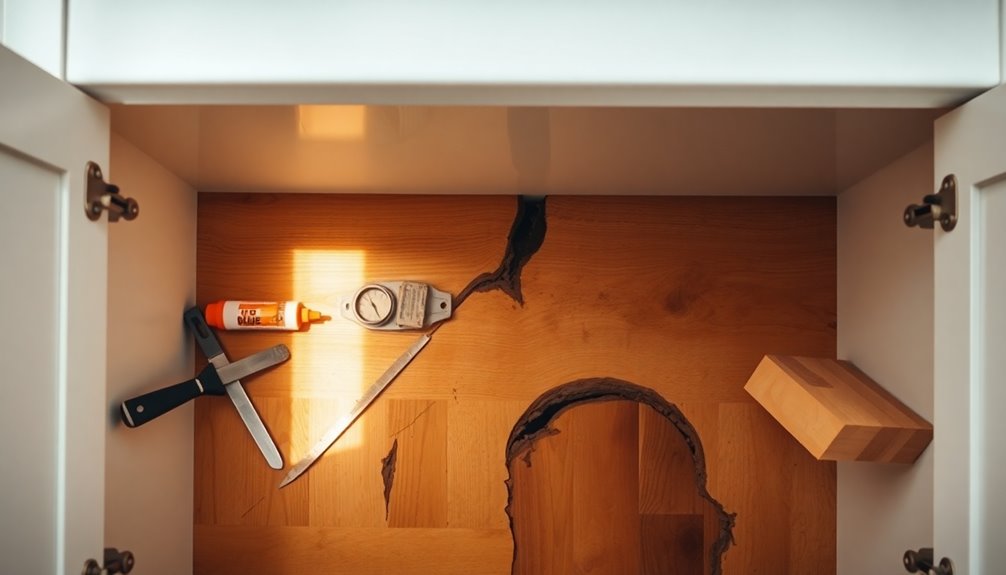
When you discover rotted wood under your sink, it is crucial to act quickly to prevent further damage. Start by evaluating how badly the wood is damaged; then, carefully remove any compromised sections using a chisel or saw. Treat the exposed area with wood hardener to reinforce the structure and prevent future rot. Fill any gaps with high-quality wood filler or epoxy for a smooth finish. Once dried, sand the area to level it with the surrounding wood and apply a waterproof sealant for added protection. If the damage is extensive, consider replacing the entire cabinet floor.
| Step | Action | Purpose |
|---|---|---|
| Assess Damage | Check extent of rot | Determine necessary repairs |
| Remove Compromised Wood | Use chisel or saw | Clear damaged material |
| Apply Sealant | Coat the repaired area with waterproof sealant | Prevent future moisture issues |
How to Repair Water-Damaged Particle Board?
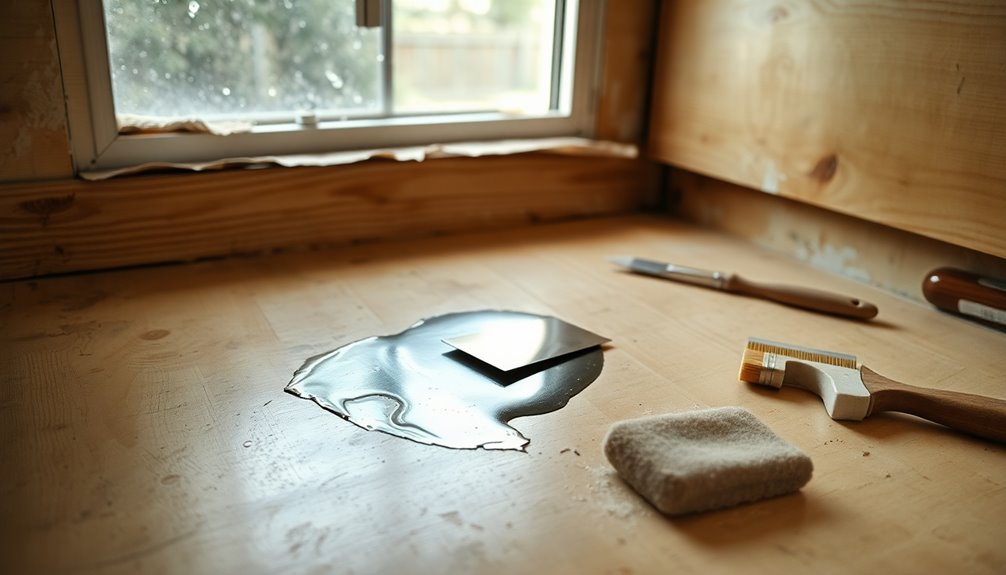
If you've encountered water-damaged particle board, addressing the issue promptly can save you from more extensive repairs down the line.
Start by thoroughly drying the area with a fan or dehumidifier to prevent mold growth.
Next, follow these steps:
- Sand the damaged particle board to eliminate swelling and warping.
- Fill any holes or gaps with wood filler or epoxy, allowing it to cure fully.
- Apply a waterproof sealant over the sanded area for future moisture protection.
- Inspect surrounding areas for hidden damage and guarantee all repairs are sealed.
Preventive Measures
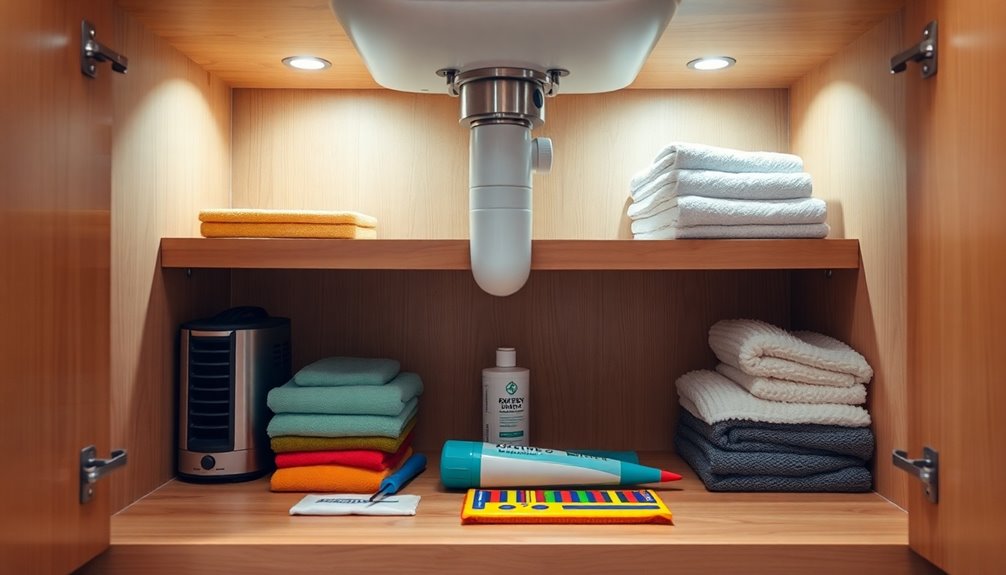
To prevent water damage in your cabinets, it is essential to take proactive steps that can protect your investment. Implementing effective preventive measures can save you from costly structural damage in the future. Here's a quick reference table to guide you:
| Action | Description | Benefits |
|---|---|---|
| Inspect Plumbing | Regularly check for leaks and repair immediately. | Prevents moisture accumulation. |
| Caulk Seams | Seal edges around the sink to create a waterproof barrier. | Reduces risk of seepage. |
| Use Waterproof Materials | Install durable boards for cabinet bases. | Enhances longevity against moisture. |
| Insulate Pipes | Minimize condensation by insulating cold water pipes. | Reduces humidity levels. |
| Improve Ventilation | Leave doors ajar or add a small fan. | Decreases humidity in cabinets. |
The Impact of Ignoring Water Damage Under the Sink
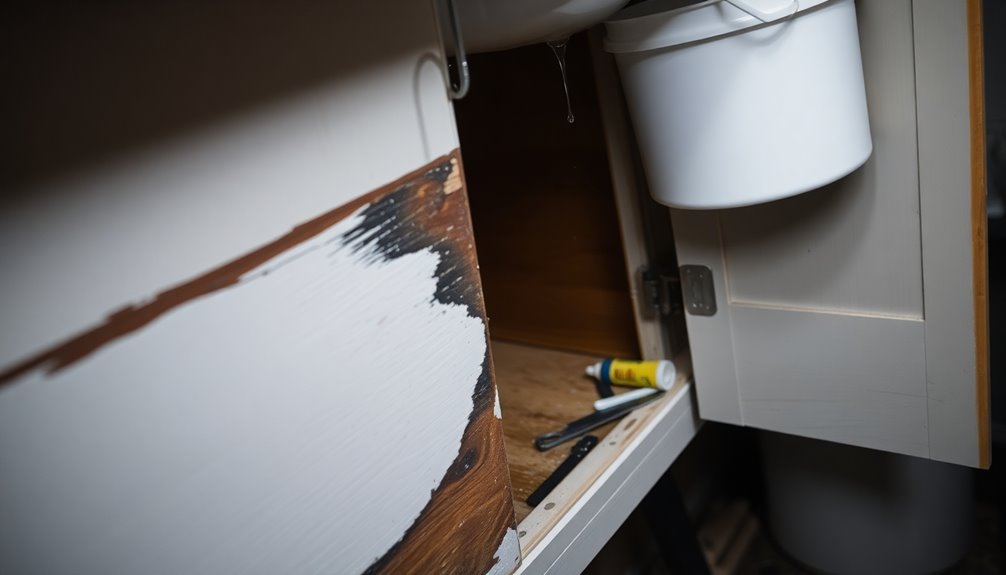
Ignoring water damage under the sink can have serious consequences that extend far beyond a simple leak.
The longer you wait, the more extensive the damage becomes, affecting not just the damaged area, but potentially your entire home.
Here's what can happen:
- Structural damage to the cabinet's integrity, leading to costly replacements.
- Mold growth, which poses health risks like allergies and respiratory issues.
- Decreased property value, as buyers may shy away from homes with visible damage.
- Hidden issues, such as termite infestations or damage to nearby structures, requiring professional help.
Addressing water damage promptly is vital to avoid these complications and protect your home and health.
Don't let a small leak turn into a major problem!
Professional Help for Water Damage Under Sink
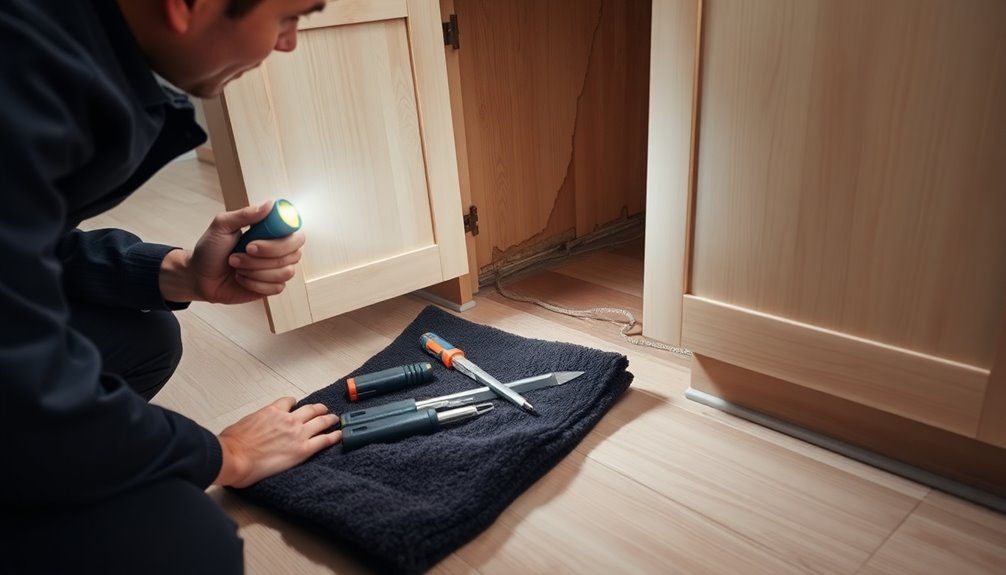
When facing water damage under your sink, hiring a professional can make a big difference.
They'll assess the situation accurately and provide thorough repair solutions that address all affected areas.
Plus, their expertise helps prevent long-term damage and costly repairs down the line.
Expert Assessment Benefits
While you might feel tempted to tackle water damage under your sink on your own, engaging professionals offers significant advantages that can make a world of difference.
Their expert assessment benefits guarantee a thorough evaluation, often revealing hidden damage that DIY methods might miss.
Professionals come equipped with specialized tools and techniques that effectively repair water damage, reducing future complications. Additionally, they can expedite the repair process, minimizing disruption to your home.
Consider these key benefits:
- Thorough evaluation of all damage
- Specialized tools for effective repairs
- Faster resolution of water damage issues
- Guidance steering through insurance claims
Investing in professional help not only addresses immediate concerns but also helps you implement long-term solutions, like new plywood, preventing future problems.
Comprehensive Repair Solutions
If you're dealing with water damage under your sink, seeking professional help can be a game changer. Experts in water damage repair provide a detailed assessment of the damage, identifying hidden issues that might escape your notice.
They use specialized tools and advanced drying techniques, guaranteeing effective remediation that goes beyond basic DIY fixes. Additionally, professionals can help you navigate the insurance process, accurately documenting the damage for your claims.
This expertise greatly reduces health risks associated with mold and structural damage, creating a safer environment. By employing high-quality materials and proven methods, they offer lasting solutions that prevent future water damage, rather than just temporary fixes.
Trusting professionals guarantees a thorough and effective recovery from water damage.
Long-Term Damage Prevention
To effectively prevent long-term water damage under your sink, enlisting professional help is essential.
Professional services offer invaluable expertise that can safeguard your cabinetry.
Here are some key benefits of hiring professionals:
- They conduct thorough evaluations of visible and hidden damage.
- Experts use specialized tools and techniques for durable repairs.
- They identify underlying issues like plumbing problems or poor ventilation.
- Professionals expedite repairs, minimizing kitchen downtime and mold risk.
- Additionally, cleanliness and hygiene are prioritized during the repair process to ensure a safe environment post-restoration.
Frequently Asked Questions
Can Water-Damaged Cabinets Be Repaired?
Yes, you can repair water-damaged cabinets in many cases.
If the structural integrity is intact, you can remove and replace the damaged wood or paneling. For minor issues, use wood filler or epoxy to restore the surface.
Don't forget to apply a waterproof sealant to prevent future problems.
However, if there's extensive rot, you might need to replace the entire base.
Always identify and fix the source of the water damage first.
What to Do if Water Gets Under Kitchen Cabinets?
Did you know that about 14% of homeowners experience water damage every year?
If water gets under your kitchen cabinets, act quickly. First, remove any items stored below and inspect for damage.
Clean the area with a vinegar-water solution to combat mold. Use fans or dehumidifiers to dry everything thoroughly.
If you find any rotting wood, cut it out and replace it.
Finally, seal seams and check plumbing regularly to prevent future issues.
How Do You Fix Water-Damaged Particle Board Under a Sink?
To fix water-damaged particle board, start by thoroughly drying the area with a fan or dehumidifier.
Inspect the board for damage; if it's swollen or warped, sand it down to regain a flat surface.
Apply a waterproof sealant for future moisture protection.
If damage is severe, cut out the affected section and replace it with new particle board, securing it with construction adhesive and nails.
Don't forget to wear safety gear!
How to Fix a Water-Damaged Swollen Wood Cabinet?
Imagine your wood cabinet, once a proud sentinel of your kitchen, now swollen and weary from water's relentless embrace.
To restore its dignity, start by drying the area thoroughly with a fan or dehumidifier.
Sand down the swollen spots gently, then apply a wood hardener to fortify the weakened fibers.
Fill in any gaps with high-quality wood filler, let it cure, and finally seal it with a waterproof finish to shield it from future moisture.
Conclusion
To sum up, tackling water damage under your sink can save you from costly repairs down the line. For instance, imagine discovering a small leak early on and quickly replacing a few rotted boards, preventing mold from spreading and avoiding a hefty restoration bill. By following the steps outlined and staying proactive, you can keep your cabinets in great shape and your home healthy. Don't wait until it's too late—take action now!
